Since my inaugural post here, my class has changed quite a bit. We began with a few rather difficult classics, but I began to feel rather desperate about introducing my students to great accessible reads without emptying my pockets. This is where literature circles come in.
In general, lit circles are scaffolded reading clubs. Each group of three to five students has a unique book they read, and every week they meet and discuss. Each person has a role, which means that the students who are usually quieter and more likely to let others lead the discussion, now must discuss! Also, because these are smaller groups, they are a bit more comfortable for my less confident students.
I was very excited about trying this out in my class, which is a mix of English Language Learners, struggling readers, and accelerated readers. Best of all, I didn’t need a set of books for the entire class; I just needed about four or five of each!
I prepared my students by first walking through a short story and doing each of the group roles together as a class. All the while, I did a quick introduction of each book and really talked up the books.
Then on Friday I put out four to six novels and had students form groups of twos and threes at the back of the classroom. There they rifled through the books and wrote down one to three books they were interested in (with a star next to their “hot choice”), and one book that they really do not want to read (optional). Prior to Choosing Day, I had already divided my students into three reading groups based on reading level so when they went to the back, only books that were in their general reading level were available. As I progressed up the levels, I would replace some of the easier books with harder books so that students generally had a few at-level and a few reach books to choose among.
Then I had the whole weekend to look at my students’ choices and determine who would read what. I considered each student’s behavior, motivation, and reading level. In the case where students really wanted to read a book that was too difficult for them, I would either let them into the group because I felt they could rise to the level, or I would let them know that currently they weren’t ready, but perhaps they could work really hard and read the book during our next set of lit circles. It is really a cool motivation.
In my next post, I will write more in detail about how the lit circles progressed, but for now I will leave you with a few popular books at varying levels for middle school students.
Short story for classroom practice
Anything by Langston Hughes is good since he writes with a pretty straightforward plot that has great characters and themes that, as one student put it, “get you in the feels.”
 A Step From Heaven by An Na
A Step From Heaven by An Na
Although this is an easier book in terms of length, type size, and even lexile, the topics of domestic abuse and immigration are pretty difficult and emotionally accessible for middle school students. Also, Na’s style of poetic prose can definitely throw students off in the beginning. I had intended for my weaker students to choose this, but it ended up that a group of three medium to high readers took this up. At first, they were a bit skeptical about the book, since it was an unfamiliar style, but towards the end, they were very engaged in the trials of the narrator as she navigates the life of an immigrant from ages four through eighteen. It was a group of two boys and one girl, and both sexes were very engaged. This was also very useful for applying figurative language knowledge.
 This Song Will Save Your Life by Leila Sales
This Song Will Save Your Life by Leila Sales
This was a hugely popular book. I had it for my higher readers since it was longer and the subject material seemed a bit older, but I think medium readers could handle this because the plot is super engaging for boys and girls alike (they were clamoring for a sequel). The story follows a female protagonist who is just pathetic at school — no matter how hard she tries, it is not just a question about fitting in with the popular group, she doesn’t fit in at all! She begins to find her niche when she starts deejaying at an underground indie club. It’s a great coming-of-age book that requires students to start critiquing the decisions of the protagonist, the supporting characters, and even the parents. Topics covered include love, cutting, and popularity.
 Breathing Underwater by Alex Flinn
Breathing Underwater by Alex Flinn
Three of my best girl readers read this book. It is from the first-person perspective of the sixteen-year-old male protagonist who is convicted for hitting his girlfriend. There is some heavy and difficult subject material in the book, including sexual references and confessions. The cover itself concerned one of my parents as it is a picture of a boy and girl about to kiss. Yet if possible, I would definitely allow mature readers to try this book. My girls in general are more dutiful about reading but are not thrilled by it. This book, however, broke that barrier, and they would come up to me and gush about what was happening in the book. I ended up buying the sequel, Diva, so that they could read to see what happens next. This never happens!
I could go on about other books, but these were definitely the winners out of the seven books we read together in class. In my next post, I will cover more in detail the roles and how I facilitated these groups. I will also cover a few more books that were popular.

The post Trial and error: lit circles appeared first on The Horn Book.
Back in January, I wrote about my preparations for all of my students to be involved in literature circles. It's interesting how the groups have evolved and the directions they are going now that they have found a rhythm in the balancing act of reading at a pace for the literature circle: making sure you meet your deadlines to be respectful of the other group members AND to be prepared for discussion PLUS to avoid the withering look Ms. Hahn might give you (along with the patient lecture about meeting deadlines, respect for other members of the group and being prepared for discussions).
The group that has been meeting continuously all through fourth and fifth grade is now 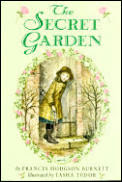 reading their "hardest" book yet -- The Secret Garden. They've been pleasantly surprised to find that although (or because?) it is their hardest book, we are having our best conversations. We're focusing on language (lots of Yorkshire-isms and old-fashioned words to puzzle out, along with some flowery similes and metaphors...no pun intended) and on how the author uses language to convey a mood.
reading their "hardest" book yet -- The Secret Garden. They've been pleasantly surprised to find that although (or because?) it is their hardest book, we are having our best conversations. We're focusing on language (lots of Yorkshire-isms and old-fashioned words to puzzle out, along with some flowery similes and metaphors...no pun intended) and on how the author uses language to convey a mood.
I wanted to push the group of capable readers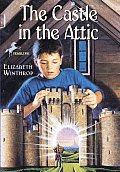 who read Mary Pope Osborne's Revolutionary War on Wednesday and The American Revolution: A Nonfiction Companion to Revolutionary War on Wednesday, so I offered The Castle in the Attic by Elizabeth Winthrop. The were wary when they held it for the first time. It was "long." Maybe "too long." So I did something I rarely do: I pretty much outlined the whole story for them as we looked at the cover picture, the blurb on the back, and the map of the castle inside. They thought it sounded like it might be good, and they decided they could probably read 25 pages in the week before we met again. The next day, the most reluctant member, who had never read a book that long and was pretty sure he couldn't, asked to reconvene the group so he could try to convince them to read more -- he had finished 25 pages in one day, he was hooked, and he knew the rule about not reading past the stopping point. If I haven't done anything else of value this year, I have shown that one student what it's like to get sucked into a story so great you don't want to put it down!
who read Mary Pope Osborne's Revolutionary War on Wednesday and The American Revolution: A Nonfiction Companion to Revolutionary War on Wednesday, so I offered The Castle in the Attic by Elizabeth Winthrop. The were wary when they held it for the first time. It was "long." Maybe "too long." So I did something I rarely do: I pretty much outlined the whole story for them as we looked at the cover picture, the blurb on the back, and the map of the castle inside. They thought it sounded like it might be good, and they decided they could probably read 25 pages in the week before we met again. The next day, the most reluctant member, who had never read a book that long and was pretty sure he couldn't, asked to reconvene the group so he could try to convince them to read more -- he had finished 25 pages in one day, he was hooked, and he knew the rule about not reading past the stopping point. If I haven't done anything else of value this year, I have shown that one student what it's like to get sucked into a story so great you don't want to put it down!

Even 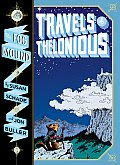 before we had finished The Travels of Thelonious, I knew what book I wanted that group to move to -- The City of Ember by Jeanne du Prau. I think the comparisons and contrasts of these two books of speculative fiction about a future where humans have almost, but not quite completely destroyed the planet (and who survives and how and why) will be fascinating. I read Thelonious for the first time with the group...great book! Review to follow soon!
before we had finished The Travels of Thelonious, I knew what book I wanted that group to move to -- The City of Ember by Jeanne du Prau. I think the comparisons and contrasts of these two books of speculative fiction about a future where humans have almost, but not quite completely destroyed the planet (and who survives and how and why) will be fascinating. I read Thelonious for the first time with the group...great book! Review to follow soon!
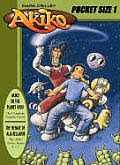
The Friday Group has finished all five books in the Akiko Pocket-Size graphic novel series. An unlikely, formerly invisible-by-choice boy has emerged as a leader in the group. He is lobbying strongly for Time Cat as the book they read next. I think it would be a perfect pick for them -- just the right mix of fantasy and history.
has finished all five books in the Akiko Pocket-Size graphic novel series. An unlikely, formerly invisible-by-choice boy has emerged as a leader in the group. He is lobbying strongly for Time Cat as the book they read next. I think it would be a perfect pick for them -- just the right mix of fantasy and history.
The A-Z Detective Camp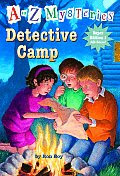 group continues to slog along at a chapter a week. They want to read something harder next time...maybe Castle in the Attic will work for them, too. Just at a slower pace than the Tuesday Group.
group continues to slog along at a chapter a week. They want to read something harder next time...maybe Castle in the Attic will work for them, too. Just at a slower pace than the Tuesday Group.
Those are the five groups from my classroom. Then, as if I didn't have enough reading to juggle, I agreed to organize a free author visit for our fourth and fifth graders. Angie Sage will be coming to our school in mid-April, compliments of HarperCollins Publishers and Cover to Cover Children's Books. We didn't have enough time to try to get every 4th and 5th grade student through one (or hopefully more) of Angie Sage's thick-ish fantasy books, so I am doing literature circles with a few fourth graders from each class and another with a few fifth graders from each class. I am listening to Magyk on cassettes in the car. It's a fun story that really moves along with lots of characters, plenty of action, a bunch of unanswered questions, and short chapters that have provocative titles. I often find myself sitting in the school parking lot or my driveway, listening for just a bit more...just until there's a good stopping spot!
Finally, in every other waking moment, I am reading The Life and Times of the Thunderbolt Kid by Bill Bryson for my adult book club. Bryson writes about growing up in the 1950's with his characteristic dry humor. My growing up started exactly ten years after the 1950's, so this sometimes reads like history for me, but much of it rings quite true. As of today, I am halfway through. Jury's still out on whether I'll be finished by Tuesday.
NOW do you understand why I have that huge pile of professional journals and NYTimes Book Reviews that lie untouched?!? Why I still haven't finished The Higher Power of Lucky, or Clementine, or Hugo Cabret?!? And sadly, not only are there books to read, there are papers to grade. Sigh.
I just finished re-reading WRINGER for the umpteenth time to be ready for the student literature circle discussion this week.
It continues to amaze me how Jerry Spinelli caught so perfectly the pain of peer pressure in this book.
It is not a pleasant story. I almost always have to convince students that it is worth reading about a kid who doesn't want to wring half-dead pigeons' necks at the town's annual pigeon shoot. Being a wringer is a right of passage for 10 year-old boys in Palmer LaRue's town. Palmer LaRue does NOT want to be a wringer. WRINGER is the story of Palmer's ultimate year of dread: from the day he turns 9 until he turns 10.
During the year of dread, Palmer is finally accepted into The Gang and given his very own nickname, Snots. He joins the gang in bullying his former friend Dorothy. And then he is "adopted" by a pigeon. Because of Nipper, Palmer is able to salvage his friendship with Dorothy, and because of Nipper, Palmer must extricate himself from the very gang to which he so wanted to belong. Because of Nipper, Palmer learns to think for himself and do what he knows is right.
There's no certain happy ending in this book. I already know (from reading response homework) that one of the students is a bit peeved about that. But there is hope. Maybe that's more important than a happy ending after all.
 A Step From Heaven by An Na
A Step From Heaven by An Na  This Song Will Save Your Life by Leila Sales
This Song Will Save Your Life by Leila Sales Breathing Underwater by Alex Flinn
Breathing Underwater by Alex Flinn









Your students are soooo lucky to have you!
Also, I've been trying to remember the Bill Bryson book ever since I heard him interviewed last fall (for some reason I thought the title had something to do with an Atomic Toilet??) and now you've saved me!
Hurrah!
There's an Atomic Toilet in the book, so you're not too far off!
There's an Atomic Toilet in the book, so you're not too far off!
Move Clementine to the top of the pile. Forget those stuffy professional journals.
I really enjoyed this post as it gave me some real insight into the reading life of your students. Please do it again sometime.
Re: "If I haven't done anything else of value this year, I have shown that one student what it's like to get sucked into a story so great you don't want to put it down!" though I'm sure you have done other things of value, I think this alone would be enough of an accomplishment. So very cool!!
And neat having Angie Sage in to visit. I listened to Magyk on MP3, and enjoyed it, but haven't gotten to the next books yet.
Wow wow wow! I second the person who said your students are so lucky to have you! I always wanted to do literature circles but never did! Lots of work for you, huh? Thanks for the very interesting post. I loved seeing what your students are reading.